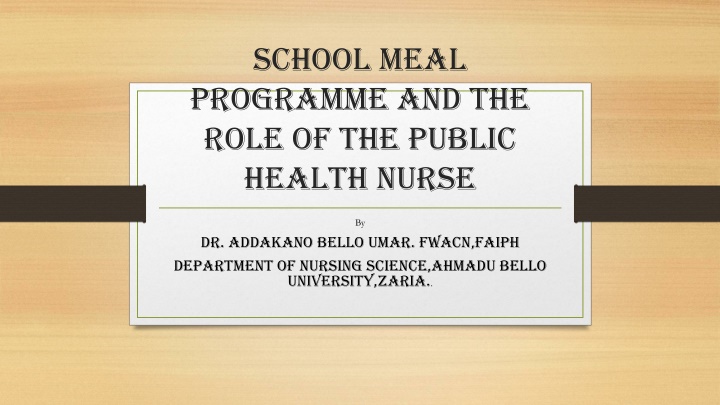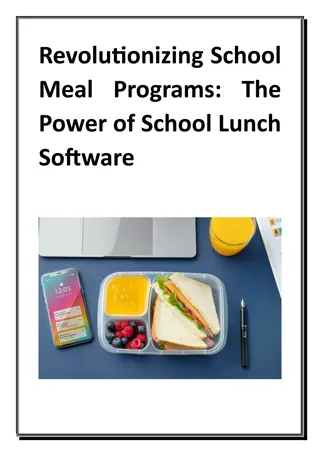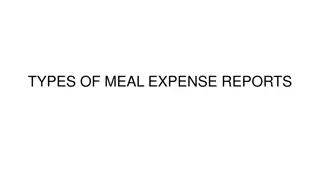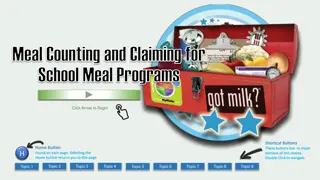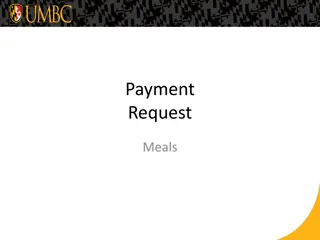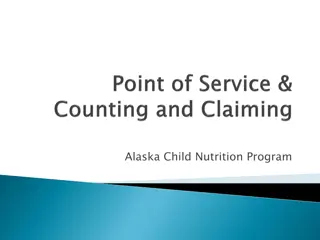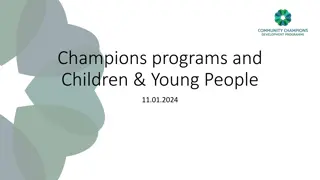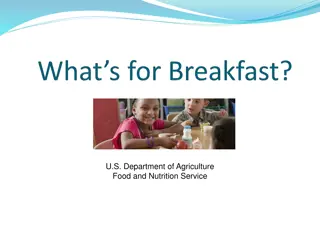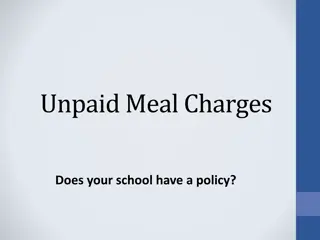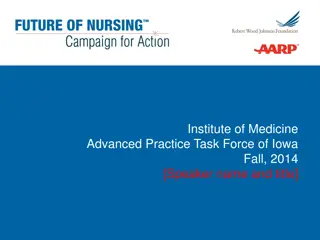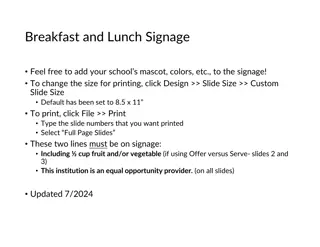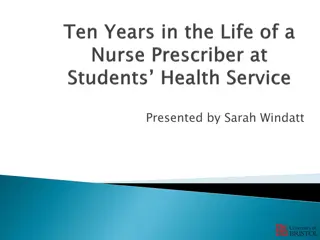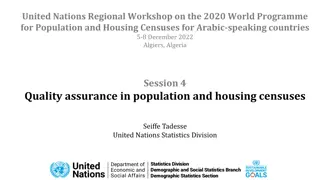Role of Public Health Nurse in School Meal Programmes
School meal programmes play a crucial role in improving the nutrition and health of children attending school. This article discusses the historical background, challenges, and implementation of school meal programmes globally, with a specific focus on Nigeria. It highlights the significance of providing daily meals to students, and emphasizes the role of public health nurses in ensuring the success of school meal initiatives.
Download Presentation

Please find below an Image/Link to download the presentation.
The content on the website is provided AS IS for your information and personal use only. It may not be sold, licensed, or shared on other websites without obtaining consent from the author.If you encounter any issues during the download, it is possible that the publisher has removed the file from their server.
You are allowed to download the files provided on this website for personal or commercial use, subject to the condition that they are used lawfully. All files are the property of their respective owners.
The content on the website is provided AS IS for your information and personal use only. It may not be sold, licensed, or shared on other websites without obtaining consent from the author.
E N D
Presentation Transcript
School meal programme and the role of the public health nurse By Dr. Addakano Bello Umar. FWACN,FAIPH Department of nursing science,Ahmadu Bello University,Zaria..
Contents Introduction Historical background Concept of school meal programme Challenges of school meal implementation Role of the public health nurse in school meal programme
Introduction Every day, countless children across the globe turn up for school on an empty stomach, which makes it hard to focus on lessons. Providing a daily school meal to these children can mean not only better nutrition and health, but also increased access to and achievement in education. 368 million school children around the world, based on a sample of 169 countries Nigeria inclusive.
Definition A school meal or school lunch (also known as hot lunch, a school dinner, or school breakfast) is a meal provided to students at school, typically in the middle or beginning of the school day.
Historical background The National School Lunch Program (NSLP) Act, in America signed by President Truman in 1946, (National School Lunch Act, P.L. 79-396, Stat. 281 [June 4, 1946]: 2), officially authorized the NSLP. The 1966 Child Nutrition Act (Child Nutrition Act, P.L. 89-642 [October 11, 1966]). expanded the program and added the School Breakfast Program (SBP) in 1975; and 1998 legislation expanded the NSLP to include reimbursements for snacks served to students in after-school educational and enrichment programs (Schirm and Kirkendall, 2010).
Historical background CONT In Nigeria, the National Home Grown School Feeding and Health Program (HGSFHP) was launched on Monday 26 September, 2005 (Akanbi and Alayande, 2011). In April 2012, the State of Osun in Nigeria pioneered a statewide school meals programme for all public elementary school pupils called the O'Meals programme. As of July 2014, it was providing lunch to over 252,000 children in 100% of Osun's elementary schools. In addition to staples such as rice, beans, and yams served with stews, soups, and vegetables, the programme provides daily fruits. Its estimated cost is N50 (USD $0.31) per child per day
Historical background CONT March 22, 2017, Nigeria s National Home Grown School Feeding Programme was revived and formally launched by the country s Vice President, Professor Yemi Osinbajo at a special meeting of Federal and State ministers and school feeding stakeholders in Abuja (Oluwolen ,2017) . The HGSF programme is part of a 500 billion Naira funded Social Investment Programme aim at feeding 24 million school children.
Goal of school meal program in Goal of school meal program in Nigeria Nigeria The overall goal of the program in Nigeria is to reduce hunger and malnutrition among school children and enhance the achievement of Universal Basic Education.
The primary objectives of the program Reduce hunger among Nigerian School Children Improve the nutritional health status of school children; Increase school enrolment, attendance, retention and completion particularly of children in rural communities and poor urban neighborhoods;
The primary objectives of the program CON T Enhance comprehension and learning achievements of pupils. Strengthening local agricultural economies by providing a school feeding market in which farmers can sell their produce. Create employment opportunities processing, farming with jobs in catering,
Benefits of school meal 1.It leads to outcomes that are mutually reinforcing, helping to lift households out of poverty to end the inter-generational cycle of hunger. 2. It also facilitates education and particularly for girls, leads to improved food security, health and nutrition, the effects of which all contribute to ending hunger. 3. it can relieve immediate short-term hunger there by improving performance..
Benefits of school meal CONT 3. School feeding helps close the gender gap in schools and helps to empower women by increasing their probability of employment. 4. When girls are educated they are more likely to have fewer and healthier children and to head families that are food-secure. 5. Maternal and infant mortality rates will decrease and better- educated girls will make more informed choices.
Benefits of school meal CONT 6. Motivate parents to enroll their children in school and have them attend regularly. 7. Address specific micronutrient deficiencies in school-age children. Most important of these are iodine and iron, which directly affect cognition. 8. Increase community involvement in schools, particularly where programs depend on the community to prepare and serve meals to children.
Types of school feeding a)Free school meal Few low-income countries provide free school meals to all pupils in compulsory education, regardless of their ability to pay. Many countries do so ,to improve attendance rates such as Nigeria, where the Government primary School students are provided with free lunch meals (Midday Meal Scheme). In high-income countries, free school meals are usually available to children who meet income-based criteria.
Types of school feeding CONT b) Reduced price meals: these are available in some countries to those who need a degree of assistance with costs. C)Take home rations where families are given food if their children attend school. (Oyefade ,2010)
Forms of Food for School Meals The meal patterns were designed assuming that the following forms of food would be used in planning menus: Fruits will be fresh, frozen without sugar, dried, or canned in fruit juice, water, or light syrup. If canned vegetables are purchased, they will contain no added salt or will be reduced in sodium content.
Forms of Food for School Meals cont To be classified as a whole grain-rich food as part of the meal standards, the food will meet the whole grain-rich food. Meats will be lean. Soya extenders are acceptable. Although meats that are preserved by smoking, curing, or salting, or by the addition of preservatives are sometimes lean, they usually are very high in sodium. Cheese and yogurt will be low fat.
Forms of Food for School Meals cont Meats will be lean. Soya extenders are acceptable. Meats that are preserved by smoking, curing, or salting, or by the addition of preservatives are sometimes lean, they usually are very high in sodium. Cheese and yogurt will be low fat. Milk offerings will be fat-free (plain or flavored) or low-fat (1 percent milk fat or less, plain only).
Forms of Food for School Meals cont Foods (such as salad dressing, dips, muffins, some entr es, and some vegetable dishes) that contain added fat will be made with unsaturated oils. The use of some unsaturated oils is encouraged because they provide vitamin E and essential fatty acids. If purchased commercially, the nutrition labeling or manufacturer s specification will indicate that the product contains 0 g of Trans fat per serving.
Meal Requirements Meal Requirements include meal standards for two general types of menu planning approaches: 1. The food-based menu planning (FBMP) approach, which focuses on the types and the amounts of foods to be offered to meet the Nutrition Standards; and 2. The nutrient-based menu planning (NBMP) approach, which makes use of computer software to plan menus that meet the Nutrition Standards.
Nutrition Standards In addition to calories, the existing Nutrition Standards focus on protein, calcium, iron, and vitamins A and C because of the roles that these nutrients play in promoting growth and development (USDA, 1995). These five nutrients were intended to serve as a practical proxy to ensure that school meals include other essential nutrients
School meals: Building blocks for Healthy children. Nutritional Standards -Foundation of school meals -Established by USDA and specified in regulation - Nutrient standards currently reflect required nutrients in calculated quantities for age-grade groups Meal requirements Nutritional standards for age-grade groups Meal requirements Implement the NUTRITIONAL STANDARDS established and specified in regulation Meal requirements consist of standards for two Types of menu planning approaches Mel requirements for nutrition based menu planning Meal requirements for food-based menu planning Standards for nutrition-based menu planning Standards for food- based menu planning Menu planning approach is selected by the school food authority and menus are developed at the local level Meal as offered to the student must meet the as offered standard for the menu planning approach. Nutrient-based standards for meals as served by the student Food based standards for meals as served by the student Meal as selected by students- as served - must meet the as served standard for the menu planning Reimbursability of meal established Components of child s meal checked by cashier Figure 1: Relationships among current Nutrition standards, Meal requirements and eligibility for Federal reimbursement.
Meal Planning Approaches 1) the food-based approach (traditional and enhanced), 2) the nutrient-based approach (nutrient standard menu planning and assisted nutrient standard menu planning), 3)Any reasonable approach The standards for menu planning include; a) food-based meal patterns that cover the types and amounts of food groups and subgroups to be offered by age-grade group;
Meal Planning Approaches cont b) specifications for minimum and maximum calorie levels and for the maximum level of saturated fat; c) specifications for sodium that are to be attained by the year 2020, with suggestions for intermediate targets and d) Specifications for trans fat that limit the amount of trans fat that any commercial food product may contain.
Implementation of Meal Requirements Successful implementation of the recommended Nutrient Targets and Meal Requirements will require attention to: key elements of achieving change - menu planning, school food service program operation, technical support for school food service operators, monitoring of the quality of school meals, and achieving long-term goals related to reducing sodium and increasing the whole grain content of school meals.
Current standard for school meal Nutrient Key nutrients Standard for the Meal School Lunch School Breakfast of the REAb , c of the RDAc of the RDAc 30% of calories <10% of calories of the REAb , c of the RDAc of the RDAc 30% of calories <10% of calories Calories Protein Calcium, iron, vitamins A and C Total fat Saturated fat Recommended but not required Cholesterol and sodium Decrease levels in the meals Increase level in the meals Increase levels in the meals Dietary fiber Grain products, vegetables, and fruits Eat a variety of foods
Key- a) These standards apply to the average content of meals over one school week (5 days). b) REA= Recommended EnergyAllowance (NRC, 1989). c) These reflect the minimum standard for the appropriate age-grade group.
Recommended as offered meal standards Breakfast Lunch Grades K-5 Grades 6-8 Grades 9-12 Grades K-5 Grades 6-8 Grades 9-12 Meal pattern Amounts of foods per meal Fruits(cups)b 5 5 5 2.5 2.5 5 Vegetables (cups) 0 0 0 3.75 3.75 5 0.5c 0.5c 0.5c Dark green 0 0 0 0.5c 0.5c 0.5c Orange 0 0 0 0.5c 0.5c 0.5c Legumes 0 0 0 Starchy 0 0 0 1 1 1 1.25c 1.25c 2.5c Other 0 0 0 Grains, at least half of which must be whole grain-richd(oz eg) 7-10 8-10 9-10 9-10 9-10 12-13 Meats, beans, cheese, yogurt,(oz eq) 5 5 7-10 8-10 9-10 10-12
Recommended as offered meal standards cont Fat-free milk (plain or flavored) or low-fat milk (1% milk fat or less) (cups) Other specifications 5 5 5 5 5 5 Other specifications: Daily amount based on the average for a 5-day week 350- 500 10 [ 430] Sodium targets are to be reached by the year 2020. Nutrition label must specify zero grams of trans fat per serving. 400-500 10 470 450-600 10 500 600-700 10 710 750-850 10 740 Min-max calories (Kcal)e,f Saturated fat (% of total calories) Sodium (mg) 550- 650 10 640 Trans fat
Key to Recommended as offered meal standards K-kindergarten, kcal=calorie; max=maximum, mg=milligram; min=minimum; ozeq=ounce equivalent. Although the recommended weekly meal intake patterns do not specify amount of unsaturated oils; their use is to be encouraged within calorie limit a. Food item included in each group and subgroup and amount equivalents. b. One cup of fruits and vegetables usually provides two servings;1/4 cup of dried fruits counts as cup of fruits,1 cup of leafy greens counts as 1 cup of vegetable
Key to Recommended as offered meal standards c. Larger amounts of these vegetables may be served. d. Based on the least half of the grain count as wholegrain. Aiming for a higher proportion of whole grain rich foods is encouraged. e. The average daily amount for 5-day school week is not to be less than the minimum or exceed the maximum
Key to Recommended as offered meal standards con t f. Discretionary sources of calories [for example, solid fats and added sugars] may be added to the meal pattern if within the specifications for calories, saturated fat, trans-fat and sodium. g. The average daily amount for a 5-day school week is not to exceed the maximum. h. Reduce the sodium content of school meals over the 10-year period in a manner that maintains student s participation rates
The costs of school feeding School feeding costs per child is a proportion of the amount that countries choose to invest in the education of the same children. Countries are remarkably consistent in their relative investment in school feeding. While there is considerable variation in the country-by-country school feeding costs ranging from less than US$20 (N.7200 ) to over US$1,500 (540,000) per child per year there is consistency when these costs are compared with other public investments in this age group.
Factors Affecting the Cost of Food in School Meals Some directly affect the cost of food or food service operation. Distributor costs, district and distributor locations; Level of competition for the business among distributors; Student, geographical, or cultural food preferences; and Variety of cooking and production methods (for example, onsite versus central kitchen with satellite sites, convenience heat and serve versus cooking from basic ingredients).
Sustainability of the school meal programme for the programmes to be sustainable is for the education and agriculture sectors to come together in support of them. On the education side, efforts should be made to reinforce the partnerships that support the quality of education and that are vital to ensure an adequate learning environment for children. WFP s renewed partnership with UNICEF and UNESCO, called
Sustainability of the school meal programme con t Nourishing Bodies, Nourishing Minds , will contribute to strengthening the quality of support on the education side. On the agriculture side, building platforms of collaboration along the supply chain has proven to be successful in several countries. A lot more remains to be done, including finding ways to leverage the support of the private sector more efficiently.
Global Challenges Implementation challenges are frequently related to limited available resources (e.g., money, time, relevant expertise) and staff motivation. Food service and food cost issues were the most frequently cited challenges for providers in complying with the nutrition standards. These included challenges in paying their food costs on a very limited budget, developing menus, incorporating variety, and cooking child- friendly meals that meet the standards.
Global Challenges cont difficulties in modifying existing recipes and scaling up recipes that are designed to comply with the new standards, reading and interpreting food labels, and increased time now required for food shopping. limited resources and experience in nutrition and physical activity and a need for ideas and resources to help children try new foods and engage in increased physical activity. Providers also experienced difficulties overcoming staff and parent resistance and engaging them positively in implementation of the changes
Global Challenges cont Carefully selecting the programme beneficiaries. Benchmarking costs and keeping track of costs. Keeping a systems view. School feeding is only part of the entire network of programmes that support vulnerable families, It should be complementing, not duplicating, the efforts of other programmes.
Global Challenges cont Planning for sufficient institutional capacity Issuing national nutrition and quality standards. Dealing with accountability, monitoring and preventing corruption: As in any other public programme, it is critical to make sure that resources are being used appropriately. Coordinating with other sectors: The ministries of health and agriculture are two important actors in school feeding.
Challenges of School feeding Programme in Nigeria More importantly, we need to take a step further and analyze some of the challenges that the school feeding system faces on a regular basis. Most recurring among the many challenges faced by the school feeding system is: the trust issue!!! By default, the average Nigerian family is built around a religious belief that is also most of the time spiced up with a rich cultural heritage.
Challenges of School feeding Programme in Nigeria The downside of this is that most of these religions and cultures are deeply rooted in a firm belief in the potency of dark supernatural forces and because of this, most of them find it difficult to trust fellow humans especially if they are of a different religious or cultural affiliation. Maintaining the cost and supply of school meal
Challenges of School feeding Programme in Nigeria con t As appalling as it might sound, it is the reality of things going on even in the wake of what we might term a takeover by modern civilization of our indigenous beliefs and culture. Another challenge that the school feeding system faces on a regular basis is the inability of the school management body to attach the needed priority it requires to run effectively and efficiently.
Role of the public health nurse in school meal programme Educator Community mobilizer Advocacy Monitoring and evaluation Researcher Collaborator Health service provider
conclusion In conclusion, it can be seen that, school meal programme is very vital in a school system. And if guided jealously can beneficial not only to the students but also to the families, communities and the Nation in general. The public health nurse is a vital resource for the success of the programme globally.
Thank You for listening Thank You for listening
